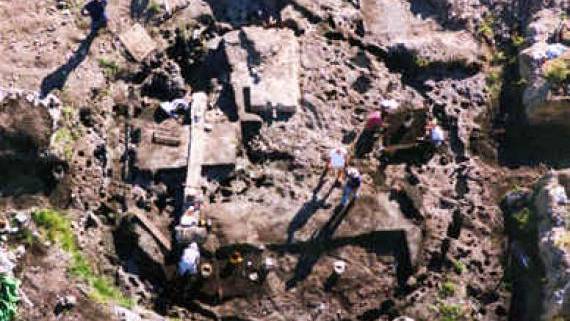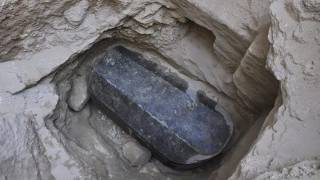The Mysterious ’Miami Circle’
Source: naturalplane.blogspot.com
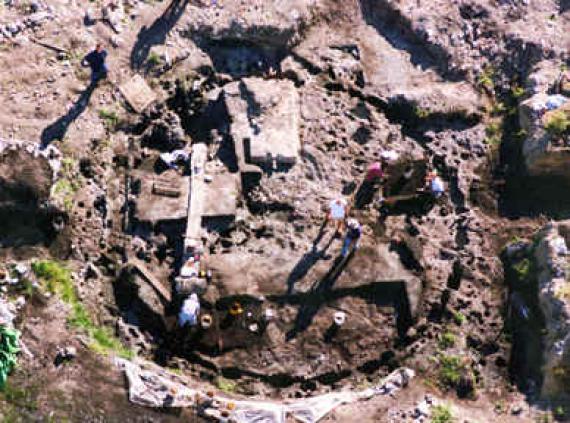
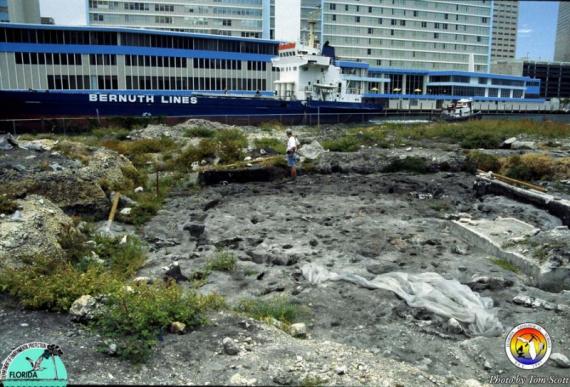
Property developer Michael Bauman was in for a real surprise when he purchased a plot of land in downtown Miami in 1998. Bauman’s plans for the land were seemingly simple: demolish a 1950-era apartment complex and build a luxury condominium in its place.
During a routine archaeological survey of the site, however, hundreds of mysterious holes were discovered in a layer of Oolitic limestone bedrock and Bauman’s development plans immediately came to a halt. Through further investigation, twenty-four of the largest holes comprised a perfect circle, 38 feet (12 m) in diameter, and excavation results found a variety of artifacts ranging from human teeth to ancient tools.
Included in the artifacts were pieces of burnt wood which, after being tested for radiocarbon dating, are believed to be 1800-2000 years old. To date, Miami Circle is the only known evidence in the United States of a prehistoric structure built into bedrock. Evidence from this mysterious prehistoric "footprint" predates other known settlements along the East Coast.
The site is believed to have once been occupied by the Tequesta Indians, a local tribe whose known tools matched some of the shark tooth-related artifacts found during excavation. Theorists have suggested that the holes were structural postholes or part of the foundation for a building. Some believe the building was used for ceremonial purposes, as animal bones and unused tools appeared to be offerings.
Among these tools were two axe-heads made from basalt, a hard stone that is not indigenous to Florida. The finding of these tools contradicts the theory that the site was occupied by the Tequesta, however, as the volcanic rock is believed to have been from a location in Macon, Georgia - some 600 miles (970 km) away from the site.
The mysterious origin of the site has led to its nickname as "America’s Stonehenge", (though there are a number of sites nicknamed this) and some critics and conspiracy theorists have offered alternative theories. Aliens, Mayans and septic tanks are among some of the suggested origins for the holes.
The State of Florida eventually purchased the land from Baumann after a series of high-profile disputes between Native American groups, contractors, and historic preservation committees. Miami Circle, otherwise known as Brickell Point or the Miami River Circle, was declared a National Historic Landmark in early 2009 and is currently under a 44-year lease agreement with the Historical Museum of Southern Florida. Visitors interested in the history of the Miami Circle can view artifacts on display through the museum’s permanent exhibition: "First Arrivals: The Archaeology of Southern Florida."
’Miami Circle’ Facts
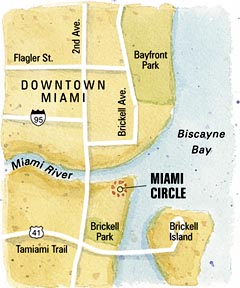 The Miami Circle was discovered in August/September, 1998, during routine archaeo-logical investigations conducted at the site of six low-rise, 1950-era apartment buildings (Brickell Point Apartments), which were razed to make way for construction of two high-rise apartment towers. Surveyor Ted Riggs uncovered an arc-like section and was convinced this would be a circle incised into the stone, underneath the three feet of overlying Earth.
The Miami Circle was discovered in August/September, 1998, during routine archaeo-logical investigations conducted at the site of six low-rise, 1950-era apartment buildings (Brickell Point Apartments), which were razed to make way for construction of two high-rise apartment towers. Surveyor Ted Riggs uncovered an arc-like section and was convinced this would be a circle incised into the stone, underneath the three feet of overlying Earth.The Miami Circle is located within archaeological site 8DA1212, aka "Miami Midden #2" or "The Brickell Point Site." It is situated on a 2.2 +/- acre parcel that is located along the southern bank of the Miami River, where the River meets Biscayne Bay. The Miami Circle is characterized primarily by a series of 24 main basin "rectangles" which have been cut almost 2 feet deep into the site’s oolitic limestone bedrock , 6 smaller ones, and hundreds of random "post holes." The 30 large and small "rectangular basins" form a ring geometry approximately 37 feet in diameter, with the approximately 500 smaller round holes scattered randomly across the entire circle’s width, if not beyond.
Considering the amount of modern construction (and demolition) that has taken place on top of the site, the Miami Circle is remarkably intact -- with approximately 85% of it preserved. The Brickell Point property contains intact prehistoric midden deposits on at least 50% - 75% of the parcel. This material contains a tremendous quantity of well-preserved shell, bone, ceramics, and other artifacts deposited during several centuries of human occupation.
The "mainstream" opinion says "the Tequesta Indians," a group of Southern Florida native Americans who inhabited the area from about 2000 years ago to after the Spanish arrived -- spanning roughly the same dates as the artifacts recovered from the Circle’s "holes." A minority opinion (Riggs, Hoagland, et al) says MUCH older ... by a sophisticated people who lived here long before the Tequestas were in the area ... perhaps as much as 10,000 to 13,000 years ago.
Archaeological evidence suggests the Miami Circle marks the footprint [foundation] of a large, prehistoric structure, possibly the "foundations for a ’Coucil House,’ or other ceremonial structure created by native Americans known as the Tequesta. The evidence also suggests that the Miami Circle had ceremonial importance to the Tequesta:
* Cardinal points (i.e. North, South, East, and West) along the Miami Circle appear to have been specially denoted. In particular, an eye-shaped hole was cut into the bedrock at the Circle’s eastern point. Its shape was unique among hundreds of holes uncovered at the site.
* Two possible animal offerings, a complete sea turtle carapace and the articulated remains of a shark more than six feet in length, were found within the Circle’s interior. Each was oriented east-west, a practice often associated with prehistoric human burials.
* Several teeth belonging to an extinct species of seal were found within the Miami Circle. Spanish explorer’s accounts indicate that the consumption of monk seals, or "sea wolves," were reserved for the elite class.
* Two finely-crafted stone axes were found found along the Miami Circle’s eastern portion. One of these was recovered from within a posthole cut into the bedrock, and possibly represents an offering. Both axes were made of basalt, a volcanic rock that is not native toFlorida.
The minority scientists say that the structure’s puzzling ring-shaped array of 30 rectangular "basins" are more analogous to England’s "Stonehenge" -- once serving as the "foundation slots" for a ring of 30 upright stones, which once stood in the currently surviving geometric bedrock basins -"an archeo-astronomical "stonehenge-like device," for observing the solstices and equinoxes, as well as other astronomically-based ceremonial uses ..."
At present, two radiocarbon date determinations have been completed. Charcoal samples collected from within one of the Miami Circle’s cut basins and from the midden within the Miami Circle both dated to circa 100 A.D. Human occupation of the site may date to well over two thousands years ago.
The Miami Circle archaeological site is regarded as being of local, regional, and statewide significance. The Miami Circle may also be of national significance, as it is believed to be the only cut-in-rock prehistoric structural footprint ever found in eastern North America. The site potentially qualifies for listing in the National Register of Historic Places. If we fail to preserve the Circle, a priceless , untouched example of a previously unsuspected sophistication in "archaic North American architecture," as well as important new clues as to the reasons for astronomically-based indigenous ceremonial centers will be lost. The Miami Circle, though architecturally unique (carved basins in the limestone bedrock), has at least one other potetially significant analog in North America: the ancient circle of wooden post holes -- called "Woodhenge 2" -- placed on the summit of a massive earthen "Indian Mound" known as "Cahokia," located across the river from St.Louis, Missouri.
The Mayor of Miami-Dade County, the Honorable Alex Penelas, signed an "eminent domain decree" last February, setting in motion a legal process for County acquisition and preservation of the Miami River Circle site. An "eminent domain" trial is set to begin October 4th to decide the actual purchase price of the land. If the County cannot raise the necessary funds in time (the exact amount to be dermined by the jury), the land will then revert back to the developer: Michael Baumann.. The County needs massive financial help, as the current "save the circle" fund is far short of even what the developer originally paid for the land.
The developer, Michael Bauman, originally paid slightly over 8 million dollars for the 2.2 acre site at the mouth of the Miami River. He is now claiming additional costs in architetural development, lost revenues due to the eminent domain proceeding, etc., totalling in excess of 50million dollars. Ultimately, based on evidence presented by the County and the developer at trial, a jury of twelve men and woman selected from the normal jury pool in the Miami area will decide what the Circle site is worth in today’s market -- and award Mr.Baumann according compensation.
Article compiled by: NaturalPlane.blogspot.com
Video from: YouTube.com
Also tune into:
Michael Tellinger - Annunaki, Mitochondrial Eve, Python Worship & Gold Mining
Michael Tellinger - Annunaki, Mitochondrial Eve, Python Worship & Gold Mining
Michael Cremo - Forbidden Archeology
Craig Hines - Gateway of the Gods
Freddy Silva - Ancient Sacred Sites, Invisible Temples, Giants & Our Ancestors
Hugh Newman - Megalithomania(cs) & Megalithic Mesoamerica
Scott Wolter - The Kensington Rune Stone
